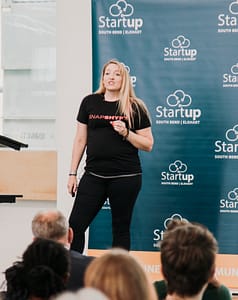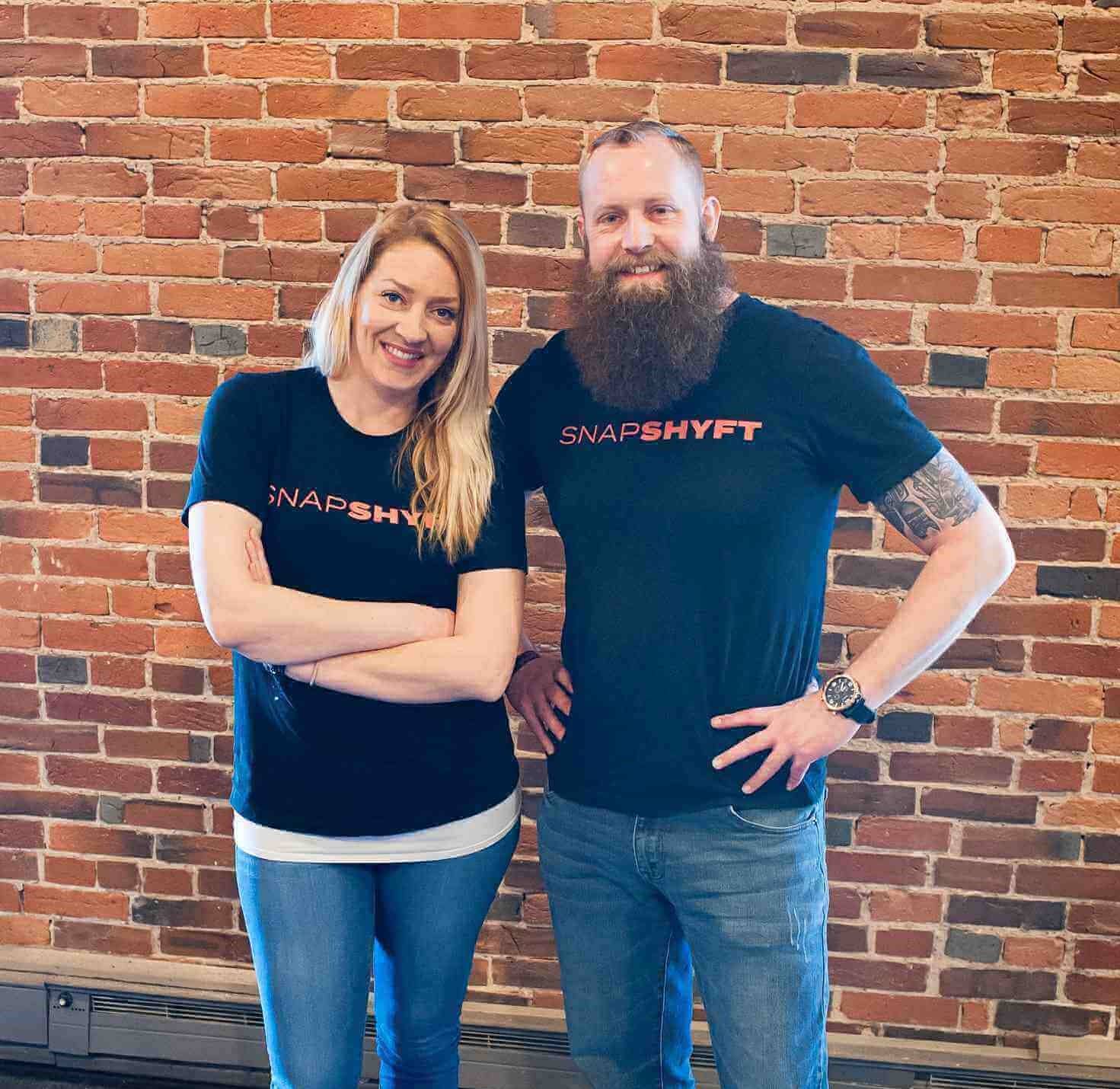Originally authored by The Startup Ladies
It’s date night. You arrive at the restaurant for a 7 p.m. reservation to find your table won’t be ready for another 15 minutes. When you finally get seated, the server is frantically working too many tables. Your food gets delayed because the kitchen is understaffed and running behind. Angry and disappointed, you leave a bad tip and head to Yelp! to warn others. What you might not know is that the hospitality industry experiences about 74% turnover every year and that this restaurant already lost more than 8% of its staff this month, which is average according to the Bureau of Labor Statistics. That tip went to a server in a job that averages less than $15 per hour. Your bad service is the product of a much bigger industry problem.
For Thor Wood and Stephanie Corliss, this story is a flashback to their time working in the hospitality industry. When they thought about the problem, one word stuck out: shift. The industry needed a shift from traditional staffing methods and available shifts needed a new way to reach the workforce. Armed with a mission to help businesses staff better and empathy to help workers earn more, Thor and Stephanie created SnapShyft. Their app combines technology with talent management to create on-demand staffing opportunities that are changing the hospitality industry one shift at a time.
What is SnapShyft?
SnapShyft is a labor marketplace that connects understaffed hospitality and food and beverage operations with qualified industry professionals on demand. In short, we fill shifts fast! Both Stephanie and I have felt the pain of the industry we serve firsthand. We knew by combining our talents and unique strengths we could build a new standard for how this industry manages staffing gaps.
We formed the company in September 2016 as we participated in the The Indy Startup Challenge, a 10-week startup bootcamp that guides potential founders through the process of building and validating a business model based on their idea.
What experiences helped you land where you are today?
 Stephanie has 20-plus years in operations, finance, accounting, and human resources. She’s worked at non-profits, Fortune 500 companies including Novellus Systems and Source Interlink Companies, and high-end resorts and country clubs. I have 12-plus years in staffing/recruiting, most recently leading N+FOB’s growth from $24 million to more than $108 million in annual revenue. Prior to starting SnapShyft, I operated my own staffing agency recruiting on behalf of Matson Inc, BTB Logistics, LDI, and others.
Stephanie has 20-plus years in operations, finance, accounting, and human resources. She’s worked at non-profits, Fortune 500 companies including Novellus Systems and Source Interlink Companies, and high-end resorts and country clubs. I have 12-plus years in staffing/recruiting, most recently leading N+FOB’s growth from $24 million to more than $108 million in annual revenue. Prior to starting SnapShyft, I operated my own staffing agency recruiting on behalf of Matson Inc, BTB Logistics, LDI, and others.
Our backgrounds in HR, operations, and recruiting have allowed us to understand the clients and users we serve. It’s enabled us to build what we wish we had available to us back when we were living the hospitality life. We’ve leveraged what we know, but we’ve also taken risks. If I sit back and recount the various encounters and experiences of the last three years, it would show that Stephanie and I possess a gambler’s mentality. We play the numbers and odds with our business and in life, so risk has become somewhat natural to us.
How has SnapShyft evolved as you’ve learned more about labor in the hospitality industry and customer needs?
We’ve evolved from strictly a business solution mentality to that of a social impact company by tending to the well-being and enablement of the workers on our platform that are underserved, underbanked and overlooked. By extension, this dramatically impacts our business clients and is evident in our more than 90% fulfillment rate (of shifts posted and shifts worked) being three times the industry average. Empathy is such a powerful tool in our arsenal, and it has been said by investors and mentors that it very well may be our superpower.
“Empathy is such a powerful tool in our arsenal, and it has been said by investors and mentors that it very well may be our superpower.”
You and Stephanie founded SnapShyft as partners. What opportunities and challenges has that afforded?
Everything is a trade-off. We traded away our time for relaxation and extracurricular shenanigans, dates and vacations, family time and personal time. In exchange, we have been able to be in our youngest children’s lives substantially. Many people think family, friends and significant others should generally avoid working together because the “separation of church and state” is a necessary thing. Stephanie and I have no such separation, which allows us to be in the game all day every day – all. day. every. day.
We know there are many impressive examples of companies founded by couples: Eventbrite, SlideShare, Houzz, Gap, Forever 21, Crate and Barrel, Cisco, VMware, Flickr, Panda Express, and others. At the end of the day, Stephanie and I have had some truly amazing exclusive privileges come about because of our decision to work together and build a business. I may have had this wild startup idea come to dominate my thoughts, but I could never have done a single part of this journey without Stephanie. From her operational, financial and compliance fluencies to keeping me grounded (somewhat!), I can assure you that SnapShyft would not exist today if she had said “no.” I am grateful we’re doing this thing together.
Building a business, developing technology and raising five children. What advice do you have for working parents aspiring to be successful entrepreneurs?
First, I must say that Stephanie is a force – period. She was doing back-to-back investor pitches in Wisconsin while in the final days of being pregnant with our youngest Lily.
Second, children emulate. In living the startup life with Stephanie and me daily they see firsthand what we do and can sense the wins and the frustrations. I’m hopeful they will learn how to tell amazing stories, manage finances and be confident enough to take risks because of this.
Finally, being a working family is hard. The children sacrifice alongside the founders. I think we both lament about missing quality time with them without work interruptions. Win or lose, it was important for us to have no regrets and there is much satisfaction to be had starting and operating your own business.
What has been your biggest aha moment as entrepreneurs?
 For a startup, speed wins and traction plus momentum are key. Commiserating doesn’t move the needle. As first-time founders, one of the most powerful opportunities is through an accelerator program. We have been fortunate to participate in five programs: The Indy Startup Challenge, gBETA, gener8tor, and 500 Startups (seed and growth programs).
For a startup, speed wins and traction plus momentum are key. Commiserating doesn’t move the needle. As first-time founders, one of the most powerful opportunities is through an accelerator program. We have been fortunate to participate in five programs: The Indy Startup Challenge, gBETA, gener8tor, and 500 Startups (seed and growth programs).
What key resources have you used that other entrepreneurs should know about?
We tend to imitate those we are around most often, so we surround ourselves with people we admire and appreciate.
We leverage an expansive network locally that includes amazing folks associated with The Startup Ladies, Powderkeg and TechPoint.
Must listen: “The Pitch”
Must read: Crossing The Chasm – Marketing and Selling Disruptive Products to Mainstream Customers
Must follows: Venture capital experts Andrew Chen and Hunter Walk
If you wrote a “do this not that” pocket guide for other entrepreneurs based on your own journey, what tips would you include?
Tip #1: Talk to your customers constantly. In fact, in the beginning before you build anything or lay down a single line of code, hit the streets and interview your target audience. Find the problem then build the solution versus building a solution for a problem that doesn’t exist.
Tip #2: Figure out the ONE metric that matters for your business and skip doing anything that doesn’t directly impact this metric.
Tip #3: Everything is a hypothesis. Run experiments as fast as possible to prove or disprove your thinking.
Tip #4: Know your numbers. Investors look for predictability, so be capable of speaking about unit economics, cohort analysis, retention, granular market sizing, and how many customers you need to achieve $100 million annual recurring revenue (ARR). Know these numbers front to back. No estimates.
Tip #5: Don’t take the easy route and only speak with people you already know well. Reach out to the new person – the shy, quiet, eager individual you see at any given event. Most likely they want to be like you, but they are scared, lacking confidence, or don’t know how to begin. Your encouragement may set them on the path. Also, make time to give back to other founders – time, feedback, advice, introductions.
Tip #6: The journey can be the reward. Have fun. Failure is the most likely outcome. Accept that and get to work. The universe will reward you with new opportunities (unless you were a “taker” and stepped over everyone during your journey).
Tip #7: You DO NOT need a technical co-founder or chief marketing officer – period.
Tip #8: Don’t get office space to say you have office space. It’s unnecessary. Go remote.
Tip #9: You get out what you put in. Show up. Do your best work.
Tip #10: Be humble.
What’s next for SnapShyft?
It’s all about our ideal customer and how plentiful they are in a given market. We have witnessed our ability to scale the worker pool quite quickly, so having the right clients means we can confidently enter new markets. We are heads-down focusing on meaningful growth and hitting our milestones. New markets are on the horizon. We are piloting in two additional major cities with a third set to kick off soon.



